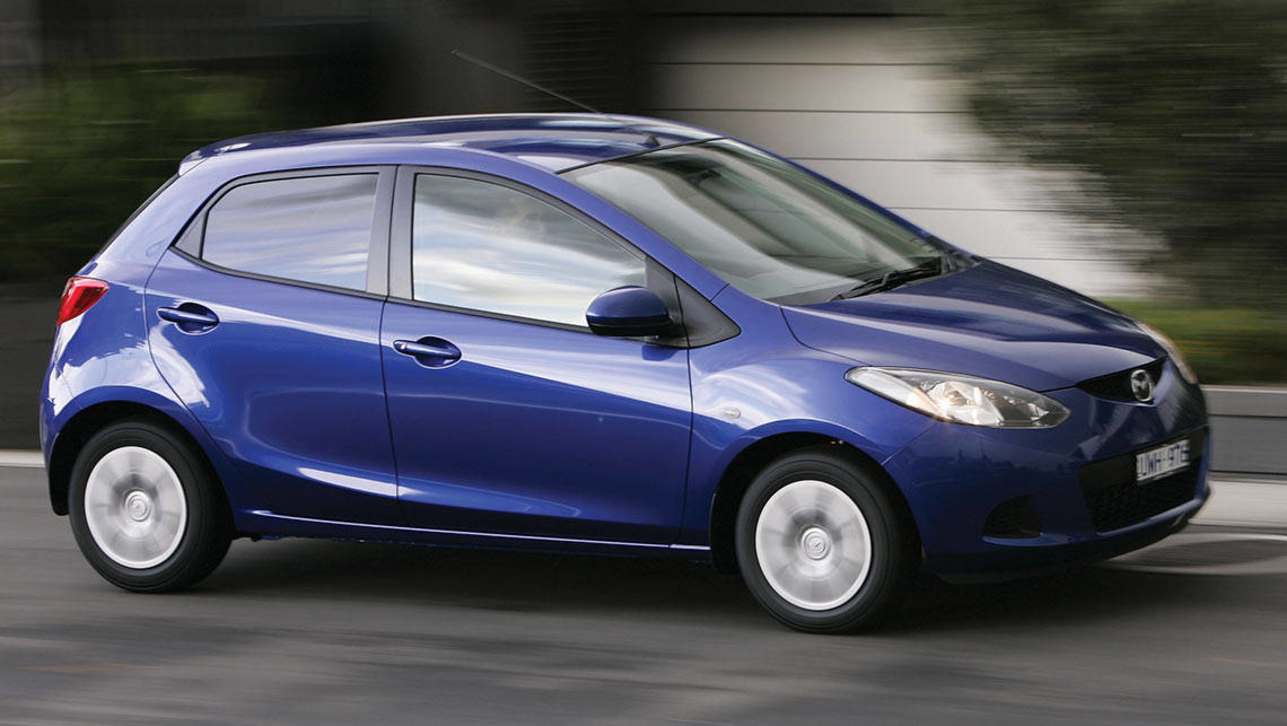Mazda has been the standout performer over the last decade or so when its cars have gone from "who cares" to "must haves" in a very short period of time.
New
It began with the ground breaking 3, continued with the 6, and then followed on with the mini 2. Sales of small cars like the Mazda2 have soared as Australians have shed their attachment to big cars and downsized like crazy.
The new 2 in 2007 promised new looks, great value and class-leading dynamics, and delivered in spades. There were four body styles, a three-door hatch, a five-door hatch and a four-door sedan, and there were three levels, the Neo, Maxx and Genki.
It was conventional for a small car. The wheels were placed at the corners to maximize its footprint for the best grip on the road and to liberate as much cabin space as possible within its compact dimensions.
Likewise, the mechanical package was typical for the class. It was powered by a 1.5-litre four-cylinder engine producing 76 kW and 137 Nm, and was claimed to do between 6.4 and 6.8 L/100km.
The cabin was quieter than before, the seats were comfortable and supportive, and it boasted lots of storage.
There was good news on the features list too, with Mazda including anti-lock brakes with brake-force distribution and emergency brake assistance, front airbags, air-conditioning, power windows and mirrors, remote central locking and iPod jack in all cars. Even better, ESP electronic stability control was available as an extra-cost option.
On the road the 2 had all the zip you could want in a small car, it handled the hustle and bustle of modern traffic well and cruised comfortably on the open road, and it cornered with good grip and balance.
Now
Mazda has won high praise for the quality of its new generation cars, and that's reflected in the views of owners who are overwhelmingly happy with the 2. The few criticisms they have are of a minor nature, and relate to individual owners needs and wants.
Owners particularly praise the fuel economy, but they also commend the car's performance, roominess and comfort.
There are no widespread issues to be concerned about, the 2 is a solid car that has been soundly engineered and well built. Owners particularly praise the fuel economy, but they also commend the car's performance, roominess and comfort.
With no endemic problems to be concerned about it's best to focus on wear-and-tear issues. Check for crash damage, things like mismatched paint, overspray that might suggest not a crash but also cheap and cheerful repairs.
Look at the corners for scratches and scrapes from nudging objects in parking lots and tight spaces etc, and go over the cabin looking for broken bits of trim and worm seats and floor coverings.
There's further good news on the recall front, there are no recalls applicable to the 2 post 2007.
As with all modern cars servicing is all-important. They are built to such fine tolerances they need regular maintenance to keep them in fine fettle and running reliably over the long-term. Some owners today look on cars as disposable items and neglect the servicing side of things, so ask for a service record that shows your chosen car has seen the inside of a workshop since it left the factory.
Mazda 2 2007: Genki
| Safety Rating |
|
|---|---|
| Engine Type | Inline 4, 1.5L |
| Fuel Type | Unleaded Petrol |
| Fuel Efficiency | 6.8L/100km (combined) |
| Seating | 5 |
| Price From | $4,180 - $6,160 |
Verdict
SMITHY SAYS
Lots of upside with the small Mazda, very little downside. Great little car.
OWNERS SAY
Jenny Harris: I traded-in a 2004 model Mazda2 on a 2013 model. I loved the 2004 model, it had a large boot and was wonderful, but I soon found the 2013 model had limited boot space, there was only one cupholder and the glovebox was awkward. It drives well and looks sleek, but the all-round vision isn't good. I wish I had done more research, and perhaps settled on a Honda Jazz or Suzuki Swift.
Bill Edwards: My 2011 Mazda2 looks smart, is zippy and comfortable, and took more luggage than I thought it would.
Edward Douglas: We have done 38,000 km in our 2011 Mazda2 and love it. It gets 6.0 L/100 km around town and 5.0 L/100 km on the open road sitting on 100 km/h. Would we buy another? You bet we would.
Chris Cornel: What a ripper little car. I travel many kilometres every day with my work and this little darling has never let me down. It's a 2007 model and I have done 223,000 km in it.
Jess Sinclair: I have had no problems so far with my 2013 Mazda2. The fuel economy is good, the seats are comfortable, and the air-conditioning is amazing. I love it.
Warren Evans: I am a 41-year-old male and I love driving my 2013 Mazda2. It is economical, zippy, easy to park, has great features and looks good.
Mazda2 2007-2013
Price new: $18,150 to $22,495
Engine: 1.5-litre 4-cyl, 76 kW/137 Nm;
Transmission: 4-speed automatic, 5-speed manual, FWD
Economy: 6.4-6.8 L/100 km
Body: 3-door hatch, 5-door hatch, 4-door sedan
Variants: Neo, Maxx, Genki
Safety: 5-star ANCAP
Expect to pay:
$6500 to $14,000 for the Neo
$7500 to $15,000 for the Maxx
$8500 to $16,500 for the Genki
OTHERS TO CONSIDER
HYUNDAI i20 – 2010-2013 One of the new generation Hyundai models that is causing buyers to rethink Korean cars. Well engineered, solidly built, reliable, economical, value for money. Pay $6500-$13,000. 4 stars.
HONDA JAZZ – 2007-2013 Perennial favourite the Jazz scores well on all counts. It's economical, roomy, and drives well. Pay $5500-$16,500. 4 stars.
TOYOTA YARIS – 2007-2013 It's a Toyota. Not a standout in the class but looks good, well built, has a flexible cabin layout, and is reliable. Pay $5200-$16,000. 3.5 stars.
COMING UP
Do you own a Mercedes-Benz C-Class? If so tell us what you think of it by sending your comments to Graham Smith at grah.smith@bigpond.com or Carsguide, PO Box 4245, Sydney, NSW, 2010.














.jpg)

.jpg)













































.jpg)
.jpg)

Comments